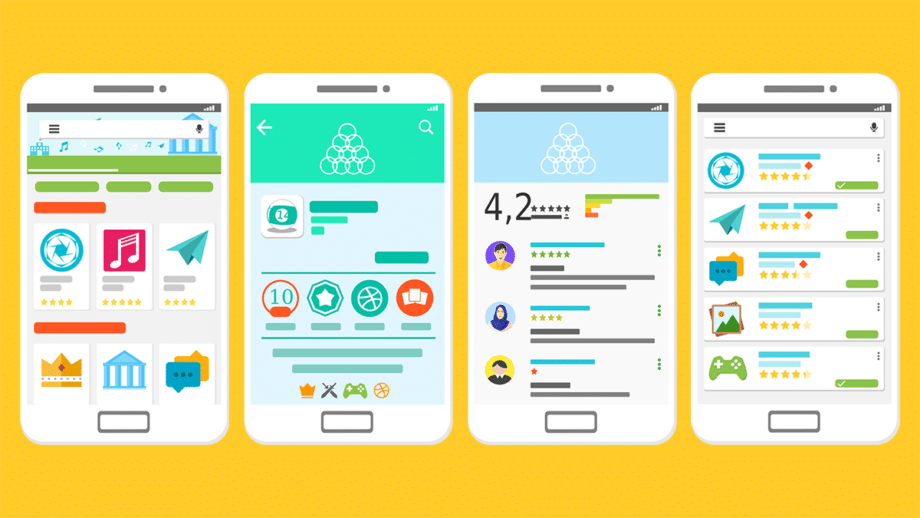Here’s a task for you! Think of all the apps on your smartphone. Can you state five reasons why you choose to use an app over and over again instead of other apps with similar functions and features? You might have narrowed down your choices to two, but ultimately, you choose “that one app.”
Now we’re getting close. We all have smartphones, which we use every day for various functions. The majority of us might not realize the emotional impact on our decision-making. In 1872, Darwin stated that emotions help humanity survive.
Many of us think technology and biology don’t go hand in hand. However, considering the emotional aspect of an application, it might help you stand out in this highly competitive app market. This is where emotionally intelligent apps come into the picture.
But what exactly is emotional user experience design? Let’s suppose there’s a mobile application that lets you express your emotions through emoticons by shaking your smartphone. Although imperceptible at first glance, it often causes an emotional response in users, making the app more engaging.
Let’s consider another example. A “404 not found page” is a dull place that no one wants to visit. But, what if we tell you that it can be transformed into something that triggers a strong emotional response from the visitors?

The majority of visitors reaching this page will attempt to leave as soon as possible. However, a well-designed 404 page can offer users links to relevant resources. This will encourage users to explore your offerings, enhancing the user experience.
Still, there’s a lot to it than this that needs to be explored. So, in this blog, we will discuss emotionally intelligent applications. We will further explore the role of AI in emotionally intelligent mobile apps and how to enhance user experience with emotional AI. Plus, we will also look at future trends.
So, without further ado, let’s dive right in!
What are Emotionally Intelligent Applications?
Today, a successful app is not only about aesthetics and performance. Forging and nurturing deeper relationships with users through an emotionally engaging app helps boost loyalty and engagement.
Emotional Intelligence (EI) and app development might seem like completely different fields, but EI can be leveraged by apps to deliver exceptional user experience. EI in app development is defined as the application’s ability to comprehend, sense, and react to user emotions.
By doing this, developers help produce personalized and interesting UX. User-empathetic applications attract prospects and retain them efficiently. To develop such an app, developers should be aware of the user requirements and motives.

Motives and Needs of the Users
- Efficiency and Convenience: As a user, do you want apps that make the task harder and more redundant? No. Right? Users usually seek AI in mobile apps that save them time and simplify their lives.
- Tailored Material: People always prefer apps that offer tailored material, including suggestions after an assessment of their interests. If a personalized experience is provided, users feel appreciated and valued.
- Emotional Well-Being: Applications offering mental health suggestions and inspirational messages increase user engagement and satisfaction.
- Social Connectivity: Most people prefer and appreciate social connectivity features. Features such as community involvement, social contacts, and sharing can endorse the feelings of an active community.
The Strategies
Developers follow various strategies when creating an emotionally driven app, considering the user’s motive and requirements. Some of them are discussed below.
- User-Centric Design: User-centered design methodology is at the core of developing apps that address user needs and motives. This includes conducting interviews, surveys, and usability testing. By understanding the target market, programmers can develop features that connect users emotionally.
- Personalization: The preference of users in the app plays a critical role in developing an app that emotionally engages them. This is where personalization comes into play. This can include offers, suggestions, and discounts based on past user behavior.
- Empathy Incorporation: Empathetic user interactions in emotionally intelligent apps! Although it is a relatively new concept, it helps users feel valued, understood, and heard. This can be achieved using a conversational UI. Virtual assistants and chatbots, designed to react sympathetically to user queries, can enable support on a deeper level. Through the incorporation of more human-like and emotionally aligned elements, UX can be improved positively.
- Emotional Analytics: Emotional analytics involves monitoring user behavior to understand their emotional state. Face recognition, biometric data, and sentiment assessment are part of this. Based on this, the responses and features of an app can be calibrated to better suit the user’s emotional requirements.

Strategic Complications
However, developers must tackle some challenges when developing emotionally intelligent apps.
- User Privacy and Security: Strong privacy and security protocols should be in place when tracking users’ emotional behavior. Users should be assured that all the data gathered to enhance the user experience is secured and managed efficiently.
- Cultural Sensitivity: Considering cultural differences and sentiments is a must for emotionally intelligent apps. Features and recommendations popular in one area might be unpopular and irrelevant in other areas. Therefore, these features must be calibrated according to geographical locations.
- Integrating AI and Human Elements: Balancing replies based on emotional behavior using AI only can negatively impact emotionally intelligent mobile apps. Without a human touch to communication, the message can become robotic and redundant. Hence, a proper integration between automation and the human element can eliminate this issue, enabling an emotionally engaging user experience.
The Role of AI in Emotionally Intelligent Mobile Apps

Suppose you walk into a digital store, and the digital assistant senses your frustration, listens to you, and offers emotionally valid solutions. No need to imagine this as this is happening right now — it’s called AI emotion recognition.
Today, tailored materials drive success; transform businesses and help startups and big enterprises alike to build deeper audience connections. But how does this work in emotionally intelligent apps? Let’s explore that in this section.
What is AI Emotion Recognition?
Emotional AI is one of the groundbreaking trends that are making waves in the AI and development industry. It is a convergence of innovative technologies that allow machines to interpret, respond, and detect human emotions.
These technologies are revolutionizing human-computer interaction, ensuring intuitiveness and emotional awareness. The following technologies are driving this transformation.

1. Neural Networks and Deep Learning
Deep learning acts as the engine that uses neural networks, simulating human emotions and perceptions. How does this technology do this? Well, they process huge datasets, entailing images, psychological indicators, and voice recordings to look for patterns of emotion.
This will drive emotional and conversational AI chatbots to become more efficient in interpreting human expressions, even the minute ones that human eyes might miss. This will be helpful for emotionally intelligent apps dealing with mental health.
2. Multimodal Fusion
We know that human emotions cannot be expressed through one medium alone. For instance, a smile can be sarcastic or genuine, and it depends on body language and vocal tone. A multimodal fusion model accesses data from a wide variety of sources, like voice, text, and facial expressions, among other psychological responses. Then it assesses all of them to develop an emotional profile.
By cross-assessment of these sources, emotional AI ensures an accurate interpretation of intricate emotions. This is highly impactful in empathetic human-machine interactions in emotionally intelligent apps, especially in education and healthcare.
3. Vocal Biomarker Assessment
Our voice carries emotional implications that even words can’t explain. Today, advanced AI can assess vocal implications like tone, speed, volume, and pitch to determine emotions.
This is useful for the BPO sector, where efficient assessment of satisfaction and frustration impacts customer experience. Even beyond this, this technique is used in the medical industry, especially in psychology, to detect neurological disorders, anxiety, and depression early.

4. BCI (Brain Computer Interfaces)
BCI (Brain Computer Interface) is transforming the emotional perception of AI systems using neurological signals. This system interprets patterns of brainwaves indicating particular emotions, allowing accurate detection of emotion.
BCI applications range from stress management to enhancing virtual reality in emotionally intelligent apps, enabling them to adapt more effectively to users’ emotional states and changing environments. The deep connection to brainwaves enables an immersive gaming experience and personalized learning.
5. Generative Emotional Artificial Intelligence
We are all aware of generative AI, which is evolving rapidly. It is now crafting emotionally aligned content like empathetic chat, emotionally rich narratives, and mood-specific music.
These AI models understand human emotions by learning from massive datasets, allowing the production of outputs that align well with user emotions. These advancements influence emotionally intelligent apps in fields like marketing, where appealing to users’ emotions can significantly enhance engagement and loyalty.
As these technologies evolve, businesses are tapping into the trend to integrate Emotional AI in their emotionally intelligent apps. Integrating emotional AI in daily mobile apps can forge stronger relationships and create tailored user interactions.
Enhancing User Experience with Emotional AI

AI has gained much popularity as a user experience design tool. It helps enhance accessibility and functionality, though these aspects are important in judging the overall user experience, they are not the only factors that a developer needs to consider.
Human emotions are an essential part of UX design today. Interpreting, dissecting, and studying user feelings in a machine-learning environment requires an exceptional ability to do so.
Without EI (Emotional Intelligence), a user interface might work just fine, but it seems dry and disengaging. So, the designers and developers of emotionally intelligent apps should trigger appropriate emotional responses from users to keep them engaged, ensuring an impactful user experience.
Where Does Emotion and AI Intersect in AI-driven UX Design?
Most of us think emotional intelligence is an important skill. Indeed, AI can never compete with the human ability to comprehend, follow, and respond to complex emotional states. However, it can certainly help designers and developers to implement this in the user experience design of emotionally intelligent apps. Here’s how to achieve that.

1. Sentiment Analysis
An exceptional UX requires a clear understanding of the users’ emotions so that it can tap into those emotions to engage them effectively. This is a prerequisite for an EI-aligned user experience design.
AI can assess chatbot conversations, comments, and reviews, opening the door to user insights on a specific topic, even when the users don’t portray it explicitly. As AI detects even minute changes from huge datasets in a short amount of time, it can be rendered an ideal tool for discovering user sentiments.
Some businesses have leveraged this assessment to substantially reduce cart abandonment by as much as 12%. They even managed to streamline website debugging timelines in a matter of a few days. This is the power of sentiment assessment when designing an intuitive UX.
2. Emotionally-Aligned Design in Emotionally Intelligent Apps
As already mentioned, emotional UX designs of emotionally intelligent apps emphasize driving user engagement by tapping into their emotions. Just like AI enables deep insights into how users feel while using the app, it can even highlight which design elements may trigger desired emotions.
The smallest change in UX design can have a big impact. That’s why designing an emotionally aligned app is tricky. About 90% of impressions stem from colors, which indicates the importance of color psychology in creating the UX design for emotionally intelligent apps.
ML models help identify these relationships, suggesting the incorporation of color psychology into the apps’ UX. For instance, a bright color can evoke action and excitement among users.
3. Personalization
Personalization can go a long way in increasing engagement and providing experiences as per user’s emotions. AI is a champion of achieving this too. This is done by segregating customer segments while adjusting interactions according to the requirements.
Crafting tailored designs that suit the user’s unique situations can amplify business conversions. AI-aligned customization can contribute to a 17% increase in lead conversions while shortening the time to tailor customization. This degree of customization is nearly impossible with such a short time frame.
Applications and Future Trends of Emotionally Intelligent Apps

When it comes to emotional AI in emotionally intelligent apps, humans have conventionally reigned supreme in understanding emotions. While some might speculate that machines mimicking human emotions are some sort of invasion, emotional AI experts deny these claims.
There is no denying the fact that today, we’re dependent on AI, and AI has become an essential part of our lives. This change will influence how we manage client interactions and emotions.
Various industries are tapping into the power of emotionally intelligent apps to grow their businesses and increase conversions. This is done by creating products and services that align with the user’s emotions.
1. Marketing
“Marketing is all about empathizing with your audience; trying to communicate a story to them, educate them, and influence them.”Nigel Hawthorn, EMEA marketing director at McAfee.
The above-mentioned quote highlights the value of user emotions in marketing. Today, marketers can quantify emotions through emotional AI:
- Marketing Communication: Enterprises can now analyze the reasons for customer engagement and customize communication strategies accordingly.
- Market Research: Emotional AI has the capability to analyze customer reactions to new offerings, enabling enterprises to make informed decisions.
- Content Optimization: Emotionally intelligent apps can further assist organizations in crafting personalized content to attract prospects and retain existing customers through proper engagement.
2. Customer Service
- Intelligent Routing: These apps can make organizations recognize frustrated clients from the start of a call while routing such calls to experienced call operators, enabling customer satisfaction.
- Recommendations: Emotionally intelligent apps can provide valuable insights into handling customer interactions based on CSPs (Comparable Speech Patterns) during the interaction.
- Constant Improvement: Product and service reviews are essential for any business. However, just 1-3% of customers on Amazon leave reviews. Affective computing or emotional AI can determine if a conversation is successful and if the customer is happy in the end.
3. HR Activities
- Recruitment: Emotional AI can enable recruiters to make better judgments. This is done by assessing the emotions conveyed by the candidates during the course of an interview.
- Training of Team Members: These apps might be used to train professionals who directly engage with the consumers. This way, these professionals can adapt to strategies best suited for the customer through proper comprehension of their emotions.
- Gauging Satisfaction: These apps allow HR professionals to monitor employees’ stress and anxiety levels. However, prior employee consent is needed due to ethical factors.
Future Trends of Emotional AI

As the research advances in the field of neural networks, computing architectures, and machine learning, we are looking at a future when AI will understand and interact intelligently to human emotions.
- Simulated EI (Emotional Intelligence): While the contemporary AI models emphasize understanding human emotions externally, scientists are investigating ways to develop neural networks that can understand and learn while modulating emotions internally as well. This can enable the development of exceptional EI-driven AI models.
- AI Companions: A significant trend to watch out for in emotional AI will be the rise of AI companions or assistants with exceptional emotional capabilities. This means users will have access to a supportive and emotionally intelligent friend who can effectively resonate with them on a deeper level.
- Learning Paradigms: Confidence, recognition, frustration, and curiosity shape our learning capacity. AI systems can soon assess emotional data to accelerate their learning process. The emotional signals can serve as a feedback loop, allowing AI models to learn fluidly in emotionally aligned ways.
Final Thoughts

The incorporation of EI (Emotional Intelligence) into the development of mobile apps is an important approach to boost user engagement and satisfaction. Applications that comprehend the motivations and needs of their users and have a strong emotional resonance outperform the apps that don’t.
Emotions play a pivotal role in crafting an engaging and intuitive design UX design for these emotionally-aligned apps. However, it is important to blend AI’s efficiency and human feelings and intuition.
In the emotionally intelligent design industry, there is a need for more research and mitigation of technical challenges. But, one thing is clear; the usage of EI in app design and development brings in endless scope in the world of UX design.
As technology continues to push boundaries, emotionally intelligent apps will continue to revolutionize industries. This will create a future where customers and enterprises interact more efficiently.
The future is bright for emotional AI and emotional intelligence-oriented apps. So, tap into their huge potential today to skyrocket your business conversions and boost your revenue.






